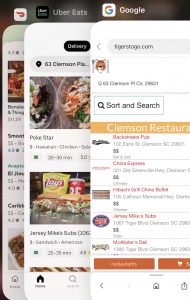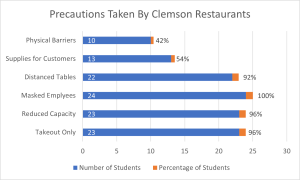15
dbcrouc; Frances Laughlin; and Tres Key
Requested raw data. Need to add more sources.
Introduction
Beyond their primary purpose of supplying food and drinks for consumption, restaurants provide a location for people to meet their need for human connection and developing social relationships (Feldman, 2015). This is especially true for the demographic of College Students. Bars and restaurants are valuable resources for a college student to form and develop social connections. Without them, the social network available to students shrinks significantly. The chapter aims to investigate the effects of the COVID-19 pandemic on restaurants and their student community at Clemson University. COVID-19 has forced restaurants to utilize and develop technology to keep their workers and clientele safe. Some of these methods include ordering through digital apps or websites and socially distanced on-site options. The restaurant industry’s flexibility and willingness to integrate technology into its daily operations has allowed society to slowly regain one of its most important social outlets. This is a clear example of how the relationship between science and technology and society is present within the restaurant industry during the COVID-19 pandemic.
Connection to STS Theory
To make a profit during the COVID-19 pandemic, restaurants had to rely on take-out orders. Rather than walk-in orders or call-ins, many restaurants chose to use apps or websites to collect orders. Also, the use of apps and websites to check seating capacities and reservations have been adopted by restaurants due to COVID-19. This is a very modern approach and way of thinking since apps, websites, and new on-site protocols were used less frequently before COVID-19. These advancements being selected over traditional communication methods are an excellent application of the modernization theory. The modernization theory dictates that “societies develop in fairly predictable stages through which they become increasingly complex. Development depends primarily on the importation of technology as well as a number of other political and social changes believed to come about as a result” (Crossman,2019). Clemson restaurants used widely available technology to develop their ordering and communication procedures due to the social change driven by COVID-19.
Detrimental Effects COVID-19 Has Had on Restaurants
The figures below contain information about the behavior of Clemson students when it came to eating out at restaurants before and during the pandemic. As you can see, the frequency with which these students attended restaurants decreased steadily, with the “once-a-week” option shrinking from 41.7% pre-pandemic to 29.2% during the pandemic. The “twice a week” and “3 times a week or more” options also shrunk noticeably. The most significant growth was seen in the “once every other week” category, with an increase of 37.5%. This data tells us that the pandemic affected students’ habits and social behavior significantly, and Clemson restaurants were receiving less business during these times.
The financial strain on Clemson Restaurants was not unique; the National Restaurant Association estimates that compared to pre-pandemic levels, restaurant employment is down close to 2.5 million jobs and that the industry lost $240 billion in sales in 2020 (National Restaurant Association, 2021).
Many restaurants had to declare bankruptcy because they had no source of income to pay taxes and fees. After this occurred, many states agreed to allow take-out online ordering via calls, apps, and websites. Then, these owners pushed for the reopening of restaurants with limited seating capacity and the following or strict protocols to ensure safety.
Action Restaurants Have Taken to Ensure Customer Safety

In response to COVID-19, restaurants have had to get creative to stay open for business. An opportunity for “COVID-19 friendly” growth is having customers order through apps and websites. As you can see in the visual on the right, many local Clemson Restaurants have expanded into the delivery business through TigersToGo, GrubHub, and UberEats. Also, apps have been updated and developed to make the ToGo part of their business streamlined and efficient. These actions have been encouraged by the CDC as well, with their recommendations being to “Offer drive-through, curbside take out, or delivery options as applicable. Prioritize outdoor seating as much as possible. (CDC.INFO 2020)” It is believed that this new way of eating out will continue even after the majority of the population is vaccinated. This new method of consumption has become convenient and normal for society, especially for tech-savvy students who have busy schedules. A well-designed app helps to track and prioritize orders during a dinner rush without any face-to-face interaction. This new way is convenient for both the customers and employees, and it ensures the safety of all parties involved.
Dine-In Protocols and Strategies for Clemson Restaurants
If restaurants wanted to reopen their dine-in option to the public, they were expected to follow COVID-19 protocols to minimize the chances of spreading the virus. The bar graph below depicts the precautions that Clemson students took note of when they chose to dine out during the pandemic. The three most common precautions taken by Clemson Restaurants were “Takeout Only”, “Masked Employees”, and “Reduced Capacity”.

Conclusion
In conclusion, COVID-19 has led to the development and utilization of digital apps, websites, and options to ensure the safety of restaurants and customers in the food industry. These tools provided the restaurant industry with opportunities to adapt quickly and expand into a new revenue stream. Without technology, many establishments would not have been able to keep their doors open. As the world waits for the return of casual lunches and crowded bars, it’s important to remember to support your local restaurants and stay safe while doing it.
Chapter Questions
- Compare the benefits and downsides for restaurants using services like Uber Eats, Grubhub, Postmates, etc.
- Examine how your personal dining habits changed during the pandemic
Supplementary Materials
References
CDC.INFO. (2020, December 16). Considerations for Restaurants and Bars. Centers for Disease Control and Prevention. https://www.cdc.gov/coronavirus/2019-ncov/community/organizations/business-employers/bars-restaurants.html#anchor_1589927161215.
Crossman, A. (2019, September 19). What is Modernization Theory? ThoughtCo. https://www.thoughtco.com/modernization-theory-3026419.
Feldman, E. (2015, February 22). Why the Restaurant Industry is the Most Important Industry in Today’s America. Medium. https://medium.com/@EliFeldman/why-the-restaurant-industry-is-the-most-important-industry-in-todays-america-6a819f8f0ac9#:~:text=Beyond%20the%20basic%20purpose%20of,and%20makeup%20of%20our%20cities.
National Restaurant Association. (2021). Reopening & Recovery. National Restaurant Association. https://restaurant.org/manage-my-restaurant/business-operations/covid19/recovery.
